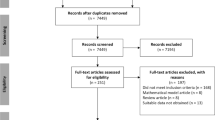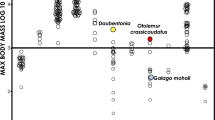Abstract
Food-associated calls have received much research attention due to their potential to refer to discovered food in a word-like manner. Studies have found that in many species, food-associated calls attract receivers to the food patch, suggesting these calls play roles in food sharing, cooperation and competition. Additionally, in various species, these calls play a role that has received much less attention: mediating social interactions among foragers that are already nearby or within the food patch, independently of whether they attract outside foragers. In order to increase understanding of the function of the chimpanzee (Pan troglodytes) food-associated rough grunt, we conducted captive playback studies testing whether rough grunt playbacks attract, repel or have no effect on the proximity of foragers already familiarized with the presence of food. We tested how acoustic playbacks of rough grunts (or control calls) from one of two known, identical feeding sites affected receivers’ approach and feeding behaviors. More often than expected, participants first approached the feeding site from which rough grunts, but not control calls, were broadcast. However, neither condition increased the likelihood that participants fed first from a given site. Our results support the hypothesis that rough grunts elicit an approach response in receivers, while providing no evidence that they repel. In addition, our study provides evidence that receivers may approach rough grunts even if they do not intend to feed. We discuss the information rough grunts may convey to receivers beyond information about discovered food and the potential benefits signalers may gain from this calling behavior.





Similar content being viewed by others
References
Alberts SC, Altmann J, Wilson ML (1996) Mate guarding constrains foraging activity of male baboons. Anim Behav 51:1269–1277
Arcadi AC (1996) Phrase structure of wild chimpanzee pant hoots: patterns of production and interpopulation variability. Am J Primatol 39(3):159–178. https://doi.org/10.1002/(sici)1098-2345(1996)39:3%3c159::aid-ajp2%3e3.0.co;2-y
Benz JJ, Leger DW, French JA (1992) Relation between food preference and food-elicited vocalizations in golden lion tamarins (Leontopithecus rosalia). J Comp Psychol 106(2):142–149. https://doi.org/10.1037/0735-7036.106.2.142
Boinski S, Campbell AF (1996) The huh vocalization of white-faced capuchins : a spacing call disguised as a food call? Ethology 102:826–840
Brosnan SF, de Waal FBM (2000) Regulation of vocal output by chimpanzees finding food in the presence or absence of an audience. Evol Commun 4(2):211–224. https://doi.org/10.1075/eoc.4.2.05bro
Brown CR, Bomberger Brown M, Shaffer ML (1991) Food-sharing signals among socially foraging cliff swallows. Anim Behav 42:551–564
Bygott J (1979) Agonistic behaviour, dominance, and social structure in wild chimpanzees of the Gombe National Park. In D. A. Hamburg & E. R. Mccown (Eds.), The great apes. Benjamin/Cummings, Menlo Park
Caine NG, Addington RL, Windfelder TL (1995) Factors affecting the rates of food calls given by red-bellied tamarins. Anim Behav 50:53–60
Chapman CA, Lefebvre L (1990) Manipulating foraging group size: spider monkey food calls at fruiting trees. Anim Behav 39(5):891–896
Clark AP, Wrangham RW (1994) Chimpanzee arrival pant-hoots: do they signify food or status? Int J Primatol 15(2):185–205
Clay Z, Smith CL, Blumstein DT (2012) Food-associated vocalizations in mammals and birds: What do these calls really mean? Anim Behav 83(2):323–330
Di Bitetti MS (2005) Food-associated calls and audience effects in tufted capuchin monkeys. Anim Behav 69(4):911–919
Di Bitetti MS, Janson CH (2001) Social foraging and the finder’s share in capuchin monkeys, Cebus apella. Anim Behav 62(1):47–56. https://doi.org/10.1006/anbe.2000.1730
Elgar MA (1986a) House sparrows establish foraging flocks by giving chirrup calls if the resources are divisible. Anim Behav 34:169–174
Elgar MA (1986b) The establishment of foraging flocks in house sparrows: risk of predation and daily temperature. Behav Ecol Sociobiol 19:433–438
Elowson AM, Tannenbaum PL, Snowdon CT (1991) Food-associated calls correlate with food preferences in cotton-top tamarins. Anim Behav 42(6):931–937. https://doi.org/10.1016/S0003-3472(05)80145-9
Engh AL, Hoffmeier RR, Cheney DL, Seyfarth RM (2006) Who, me? Can baboons infer the target of vocalizations? Anim Behav 71(2):381–387. https://doi.org/10.1016/j.anbehav.2005.05.009
Evans CS, Evans L (1999) Chicken food calls are functionally referential. Anim Behav 58(2):307–319
Evans CS, Evans L (2007) Representational signalling in birds. Biol Let 3(1):8–11
Evans CS, Marler P (1994) Food calling and audience effects in male chickens, Gallus gallus: their relationships to food availability, courtship and social facilitation. Anim Behav 47:1159–1170
Fedurek P, Slocombe KE (2011) Primate vocal communication: a useful tool for understanding human speech and language evolution? Hum Biol 83(2):153–173
Fedurek P, Slocombe KE (2013) The social function of food-associated calls in male chimpanzees. Am J Primatol 75(7):726–739. https://doi.org/10.1002/ajp.22122
Georgiev AV, Russell AF, Emery Thompson M, Otali E, Muller MN, Wrangham RW (2014) The foraging costs of mating effort in male chimpanzees (Pan troglodytes schweinfurthii). Int J Primatol. https://doi.org/10.1007/s10764-014-9788-y
Goodall J (1986) The chimpanzees of gombe: patterns of behavior. Harvard University Press, Cambridge
Gros-Louis J (2004a) The function of food-associated calls in white-faced capuchin monkeys, Cebus capucinus, from the perspective of the signaller. Anim Behav 67(3):431–440
Gros-Louis J (2004b) Responses of white-faced capuchins (Cebus capucinus) to naturalistic and experimentally presented food-associated calls. J Comp Psychol 118(4):396–402
Hake M, Ekman J (1988) Finding and sharing depletable patches—when group foraging decreases intake rates. Ornis Scand 19(4):275–279. https://doi.org/10.2307/3676721
Hauser MD, Marler P (1993) Food-associated calls in rhesus macaques (Macaca mulatta): II. Costs and benefits of call production and suppression. Behav Ecol 4(3):206–212
Hauser MD, Wrangham RW (1987) Manipulation of food calls in captive chimpanzees. Folia Primatol 48:207–210
Hauser MD, Teixidor P, Field L, Flaherty R (1993) Food-elicited calls in chimpanzees: effects of food quantity and divisibility. Anim Behav 45:817–819. https://doi.org/10.1006/anbe.1993.1096
Heinrich B (1988) Winter foraging at carcasses by three sympatric corvids, with emphasis on recruitment by the raven, Corvus Corax. Behav Ecol Sociobiol 23(3):141–156
Heinrich B, Marzluff JM (1991) Do common ravens yell because they want to attract others? Behav Ecol Sociobiol 28(1):13–21. https://doi.org/10.1007/BF00172134
Herbinger I, Papworth S, Boesch C, Zuberbühler K (2009) Vocal, gestural and locomotor responses of wild chimpanzees to familiar and unfamiliar intruders: a playback study. Anim Behav 78(6):1389–1396. https://doi.org/10.1016/j.anbehav.2009.09.010
Hopkins WD, Tagliatela J, Leavens DA (2007) Chimpanzees differentially produce novel vocalizations to capture the attention of a human. Anim Behav 73(2):281–286
Hopper LM, Lambeth SP, Schapiro SJ, Brosnan SF (2013) When given the opportunity, chimpanzees maximize personal gain rather than “level the playing field. PeerJ 1:e165
Houle A, Wrangham RW (2021) Contest competition for fruit and space among wild chimpanzees in relation to the vertical stratification of metabolizable energy. Anim Behav 175:231–246. https://doi.org/10.1016/j.anbehav.2021.03.003
Ischer G, Zuberbühler K, Fedurek P (2020) The relationship between food calling and agonistic behaviour in wild chimpanzees. Behav Proc 178(May):104182. https://doi.org/10.1016/j.beproc.2020.104182
Janik VM (2000) Food-related bray calls in wild bottlenose dolphins (Tursiops truncatus). Proc R Soc B Biol Sci 267(1446):923–927. https://doi.org/10.1098/rspb.2000.1091
Jiang T, Long Z, Ran X, Zhao X, Xu F, Qiu F, Kanwal JS, Feng J (2016) Using sounds for making decisions: greater tube-nosed bats prefer antagonistic calls over non-communicative sounds when feeding. Biol Open 5(12):1864–1868. https://doi.org/10.1242/bio.021865
Kalan AK, Boesch C (2015) Audience effects in chimpanzee food calls and their potential for recruiting others. Behav Ecol Sociobiol 69(10):1701–1712. https://doi.org/10.1007/s00265-015-1982-1
Kalan AK, Mundry R, Boesch C (2015) Wild chimpanzees modify food call structure with respect to tree size for a particular fruit species. Anim Behav 101:1–9
Kazahari N (2014) Maintaining social cohesion is a more important determinant of patch residence time than maximizing food intake rate in a group-living primate, Japanese macaque (Macaca fuscata). Primates 55(2):179–184. https://doi.org/10.1007/s10329-014-0410-x
Kitzmann CD, Caine NG (2009) Marmoset (Callithrix geoffroyi ) food-associated calls are functionally referential. Ethology 115(5):439–448. https://doi.org/10.1111/j.1439-0310.2009.01622.x
Krebs JR, Dawkins R (1984) Animal Signals: mind reading and manipulation. Behavioural ecology: an evolutionary approach, 2nd edn. Blackwell, Oxford, pp 380–402
Laidre ME (2006) Manipulation without mind-reading: information suppression and leakage during food discovery by mandrills (Mandrillus sphinx). Behaviour 143:365–392
Marler P, Tenaza R (1977) Signaling behavior of apes with special reference to vocalizations. In: Sebeok TA (ed) How animals communicate. Indiana University Press, pp 965–1033
Marler P, Dufty A, Picker R (1986) Vocal communication in the domestic chicken. I: does a sender communicate information about the. Anim Behav 34:188–193
Marler P, Evans CS, Hauser MD (1992) Animal signals: motivational, referential or both? In: Papousek H, Jürgens U, Papoušek M (eds) Nonverbal vocal communication: comparative and developmental approaches. Cambridge University Press, Cambridge
O’Bryan LR, Lambeth SP, Schapiro SJ, Wilson ML (2020) Unpacking chimpanzee (Pan troglodytes) patch use: Do individuals respond to food patches as predicted by the marginal value theorem? Am J Primatol. https://doi.org/10.1002/ajp.23208
Owren MJ, Rendall D (2001) Sound on the rebound: bringing form and function back to the forefront in understanding nonhuman primate vocal signaling. Evol Anthropol 10(2):58–71
Radford AN, Ridley AR (2008) Close calling regulates spacing between foraging competitors in the group-living pied babbler. Anim Behav 75(2):519–527
Rendall D, Seyfarth R, Cheney D, Owren M (1999) The meaning and function of grunt variants in baboons. Anim Behav 57(3):583–592. https://doi.org/10.1006/anbe.1998.1031
Reynolds V, Reynolds R (1965) Chimpanzees of the Budongo Forest. Primate behavior: field studies of monkeys and apes. Rinehart & Winston, New York, pp 368–424
Schel AM, Machanda Z, Townsend SW, Zuberbühler K, Slocombe KE (2013) Chimpanzee food calls are directed at specific individuals. Anim Behav 86(5):955–965. https://doi.org/10.1016/j.anbehav.2013.08.013
Seyfarth RM, Cheney DL (2010) Production, usage, and comprehension in animal vocalizations. Brain Lang 115(1):92–100. https://doi.org/10.1016/j.bandl.2009.10.003
Slocombe KE, Zuberbühler K (2005) Functionally referential communication in a chimpanzee. Curr Biol 15(19):1779–1784
Slocombe KE, Zuberbühler K (2006) Food-associated calls in chimpanzees: responses to food types or food preferences? Anim Behav 72(5):989–999
Slocombe KE, Kaller T, Turman L, Townsend S, Papworth S, Squibbs P, Zuberbühler K (2010) Production of food-associated calls in wild male chimpanzees is dependent on the composition of the audience. Behav Ecol Sociobiol 64(12):1959–1966. https://doi.org/10.1007/s00265-010-1006-0
Wilson ML, Hauser MD, Wrangham RW (2001) Does participation in intergroup conflict depend on numerical assessment, range location, or rank for wild chimpanzees? Anim Behav 61:1203–1216
Wilson ML, Hauser MD, Wrangham RW (2007) Chimpanzees (Pan troglodytes) modify grouping and vocal behaviour in response to location-specific risk. Behaviour 144(12):1621–1653. https://doi.org/10.1163/156853907782512137
Wittig R, Boesch C (2003) “Decision-making” in conflicts of wild chimpanzees (Pan troglodytes): an extension of the relational model. Behav Ecol Sociobiol 54(5):491–504. https://doi.org/10.1007/s00265-003-0654-8
Wrangham RW (1977) Feeding behaviour of chimpanzees in Gombe National Park, Tanzania. In: Clutton-Brock TH (ed) Primate ecology. Academic Press, Cambridge
Zuberbühler K (2003) Referential signaling in non-human primates: cognitive precursors and limitations for the evolution of language. Adv Study Behav 33:265–307
Acknowledgements
We would like to thank all of the staff at the National Center for Chimpanzee Care for their wonderful care of the chimpanzees housed at the facility. L.O’B. would also like to give special thanks to staff members Rachel Haller, Emily Mocarski and Erica Thiele for their assistance with logistical aspects of the study and to Dr. Lydia Hopper for her helpful guidance and feedback throughout the study.
Funding
The chimpanzees at the National Center for Chimpanzee Care at the Michale E. Keeling Center for Comparative Medicine and Research are supported by NIH Cooperative Agreement U42 OD-011197. This study was supported by funding from the Dayton-Wilkie Natural History Fellowship from the Bell Museum of Natural History (L.O’B.) as well as a McKnight Land-Grant Professorship Award (M.L.W.).
Author information
Authors and Affiliations
Corresponding author
Ethics declarations
Ethical standards
All procedures performed in these studies adhered to the ethical standards in the protocols approved by the IACUCs of The University of Texas MD Anderson Cancer Center (UTMDACC) and the University of Minnesota (Protocol number # 1002A78194). The authors declare that they have no conflict of interest.
Additional information
Publisher's Note
Springer Nature remains neutral with regard to jurisdictional claims in published maps and institutional affiliations.
Supplementary Information
Below is the link to the electronic supplementary material.
About this article
Cite this article
O’Bryan, L.R., Lambeth, S.P., Schapiro, S.J. et al. Playbacks of food-associated calls attract chimpanzees towards known food patches in a captive setting. Primates 62, 905–918 (2021). https://doi.org/10.1007/s10329-021-00936-4
Received:
Accepted:
Published:
Issue Date:
DOI: https://doi.org/10.1007/s10329-021-00936-4




